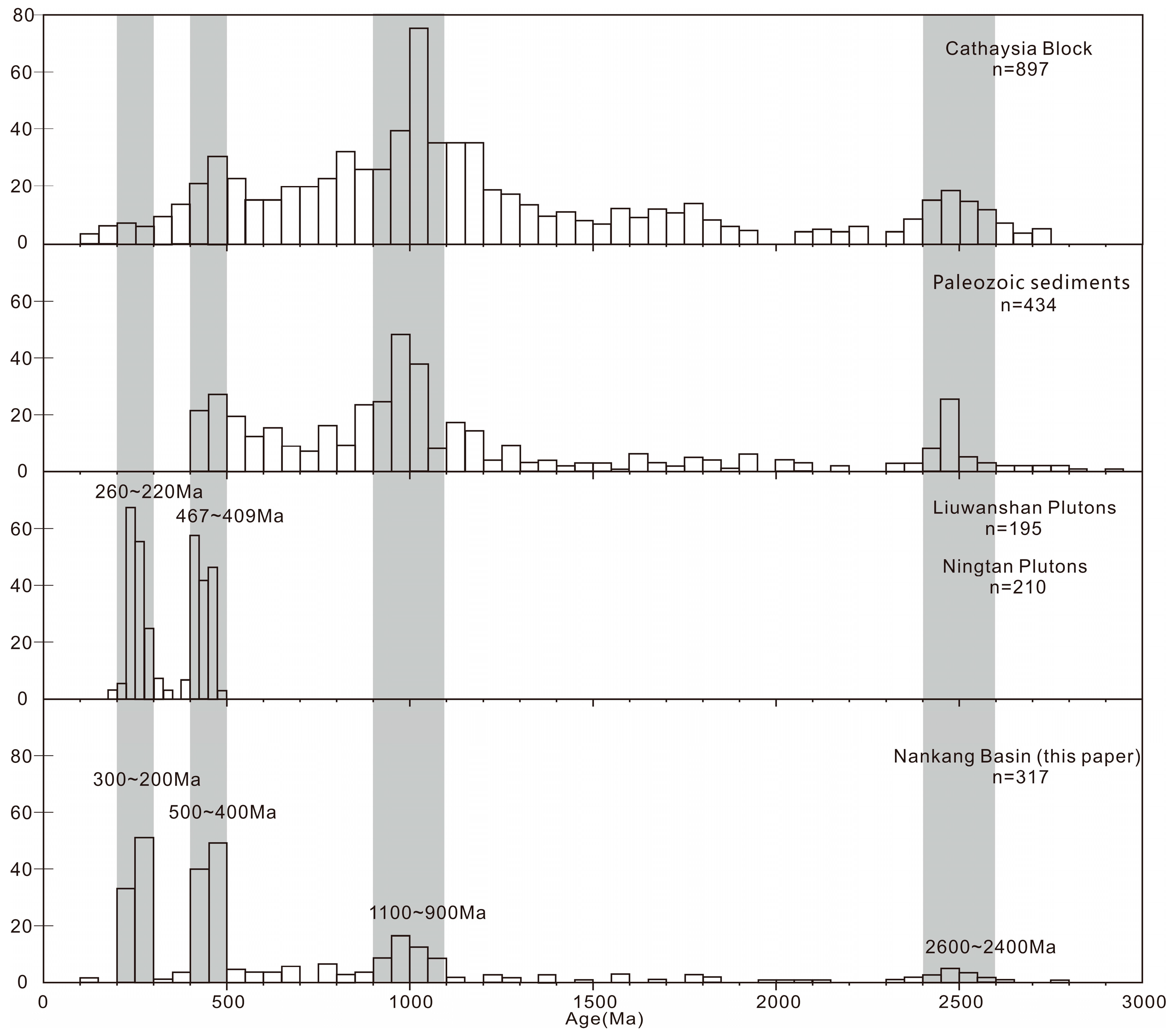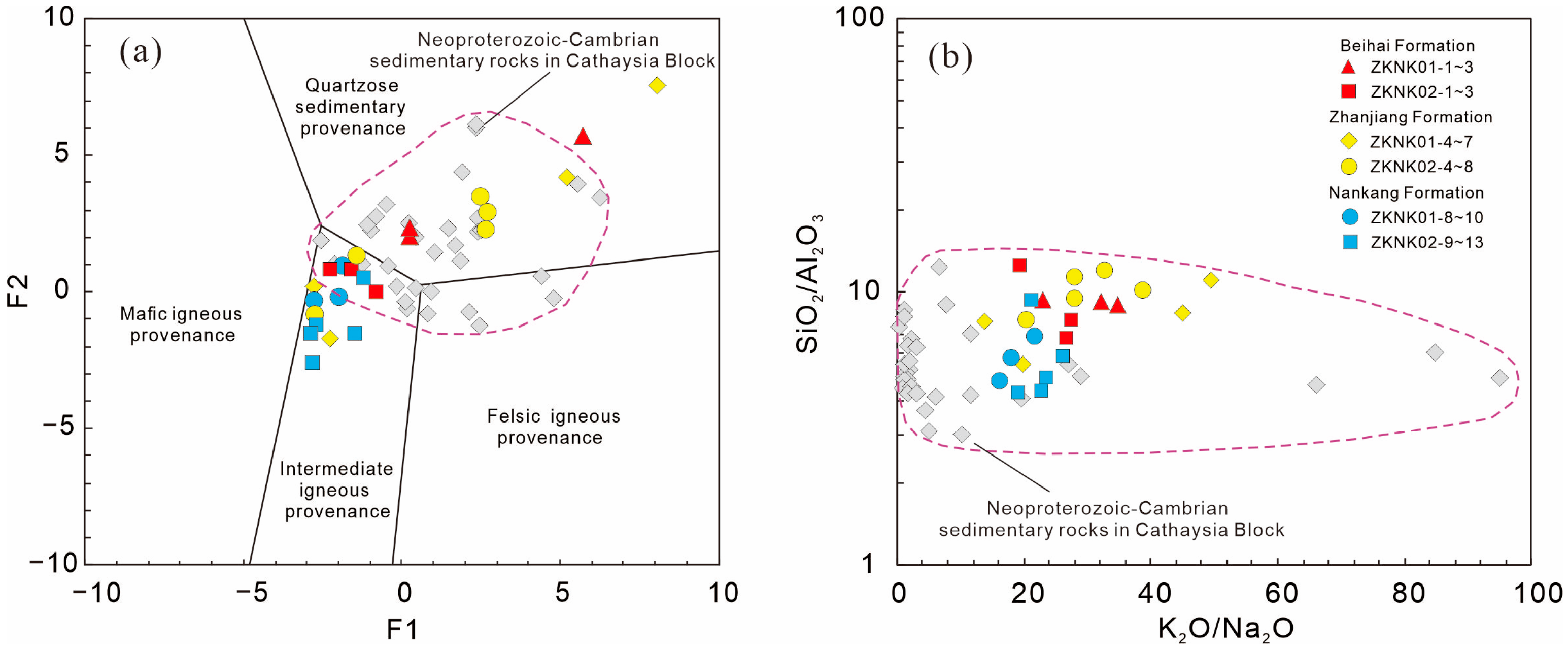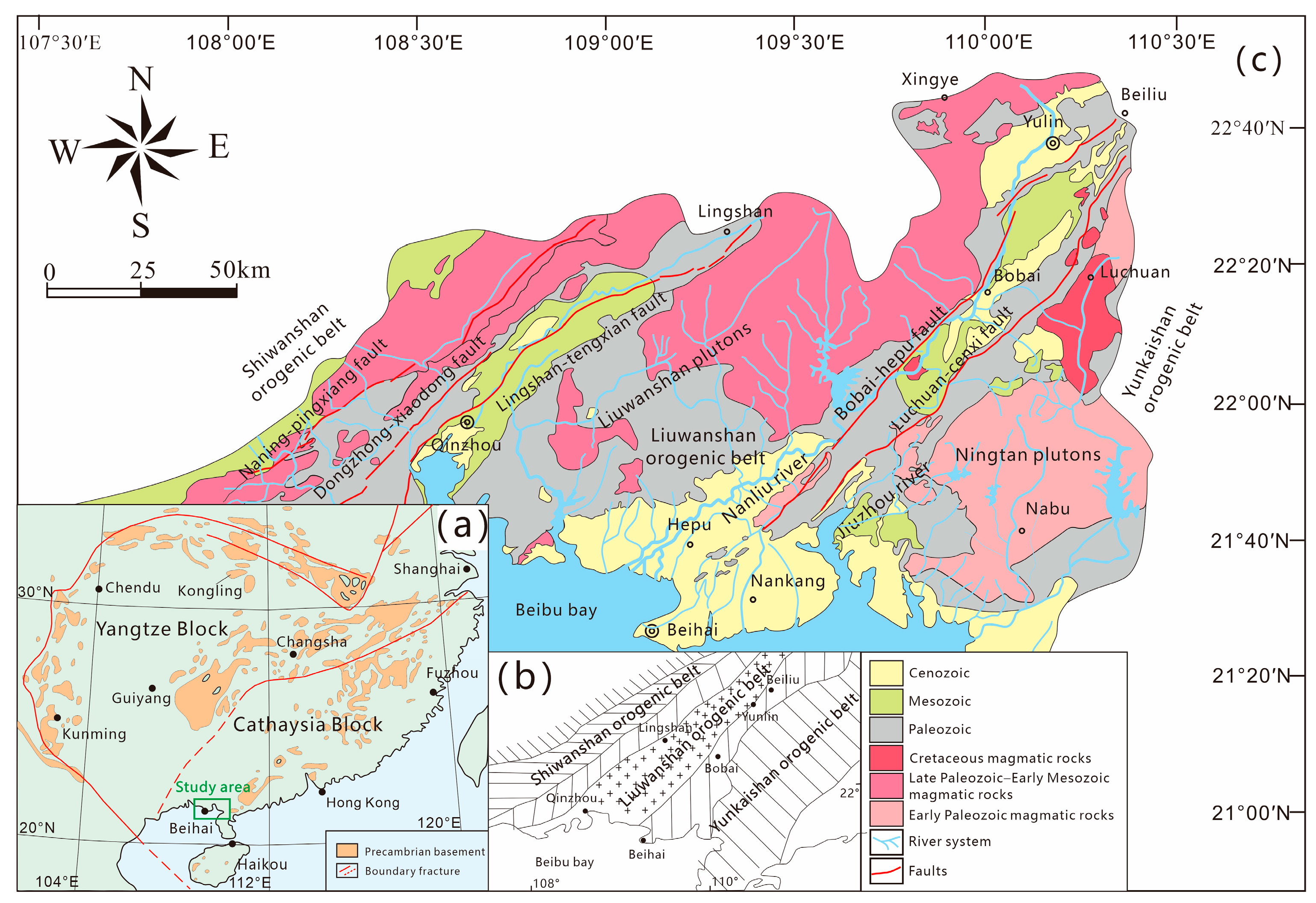Provenance and Geological Significance of Cenozoic Sandstones in the Nankang Basin, Southern Cathaysia Block, China
Abstract
1. Introduction
2. Geological Setting
3. Materials and Methods
4. Results
4.1. Sedimentary Facies Analysis
4.2. Petrography
4.3. Zircon U–Pb Geochronology
4.4. Heavy Mineral Contents
4.5. Major Element Geochemistry
5. Discussion
5.1. Tectono-Thermal Events Recorded by Detrital Zircon Grains
5.2. Provenance Inference from Zircon U–Pb Studies
5.3. Provenance Inference from Geochemical Studies
5.4. Cenozoic Tectono–Sedimentary Evolution of the Nankang Basin and Its Periphery
6. Conclusions
- The lithic fragments and heavy mineral assemblages suggest that the Cenozoic sandstones in the Nankang Basin were derived primarily from igneous and sedimentary rocks.
- The detrital zircon grains deposited in the Nankang Basin during the Neogene have four age peaks: 2500–2000, 1100–900, 500–400, and 300–200 Ma. The majority of the zircon grains belong to the 500–400 and 300–200 Ma groups. The complexity of the sediment sources indicates at least four tectono–thermal events in the zircon provenance area. A further provenance analysis indicates that the 300–200 Ma zircon grains originated mainly from the Liuwanshan pluton; the 500–400 Ma zircon grains originated from the Ningtan pluton, with a small portion originating from metamorphic rocks around the Shizishan; and the 2500–2000 and 1100–900 Ma zircon grains originated from the Silurian Liantan Formation and Devonian Xindu Formation.
- During the deposition of the Nankang Formation in the Nankang Basin, the sediment transport direction was to the NNW, whereas during the deposition of the Zhanjiang Formation, the direction changed to the NNE. The uplift of the Shizishan most probably occurred during the late Neogene and early Quaternary, separating the Nankang and Hepu Basins.
Supplementary Materials
Author Contributions
Funding
Data Availability Statement
Acknowledgments
Conflicts of Interest
References
- Mao, J.; Cheng, Y.; Chen, M.; Pirajno, F. Major types and time–space distribution of Mesozoic ore deposits in South China and their geodynamic settings. Miner. Depos. 2013, 48, 267–294. [Google Scholar] [CrossRef]
- Shu, L.; Yao, J.; Wang, B.; Faure, M.; Charvet, J.; Chen, Y. Neoproterozoic plate tectonic process and Phanerozoic geodynamic evolution of the South China Block. Earth-Sci. Rev. 2021, 216, 103596. [Google Scholar] [CrossRef]
- Zhang, X.; Xu, X.; Xia, Y.; Liu, L. Early Paleozoic intracontinental orogeny and post-orogenic extension in the South China Block: Insights from volcanic rocks. J. Asian Earth Sci. 2016, 141, 24–42. [Google Scholar] [CrossRef]
- Li, J.; Zhao, G.; Johnston, S.; Dong, S.; Yu, Y. Permo-Triassic structural evolution of the Shiwandashan and Youjiang structural belts, South China. J. Struct. Geol. 2017, 100, 24–44. [Google Scholar] [CrossRef]
- Wang, Y.; Wu, C.; Zhang, A.; Fan, W.; Zhang, Y.; Peng, T.; Yin, C. Kwangsian and Indosinian reworking of the eastern South China Block: Constraints on zircon U–Pb geochronology and metamorphism of amphibolites and granulites. Lithos 2012, 150, 227–242. [Google Scholar] [CrossRef]
- Faure, M.; Shu, L.; Wang, B.; Fan, W.; Charvet, J.; Monie, P.; Yin, C. Intracontinental subduction: A possible mechanism for the Early Palaeozoic Orogen of SE China. Terra Nova 2009, 21, 360–368. [Google Scholar] [CrossRef]
- Shu, L.; Zhou, X.; Deng, P. Geological features and tectonic evolution of Meso-Cenozoic basins in southeastern China. Geol. Bull. China 2004, 23, 876–884, (In Chinese with English abstract). [Google Scholar]
- Hutchison, C.S. Gondwana and Cathaysian blocks, Palaeotethys sutures and Cenozoic tectonics in South-east Asia. Int. J. Earth Sci. 1994, 83, 388–405. [Google Scholar] [CrossRef]
- Xu, X.; Tang, S.; Lin, S. Detrital provenance of Early Mesozoic basins in the Jiangnan domain, South China: Paleogeographic and geodynamic implications. Tectonophysics 2016, 675, 141–158. [Google Scholar] [CrossRef]
- Zhang, K.; He, W.; Xu, Y.; Wang, L.; Niu, Z.; Xing, G.; Wang, J.; Xu, D.; Zhao, X.; Somg, F. Distribution and Evolution of OPS from Proterozoic to Early Paleozoicin the Cathaysian Orogen. Geol. Bull. China 2024, 40, 181–210, (In Chinese with English abstract). [Google Scholar]
- Kang, Z.; Zhang, Q.; Guan, Y.; Feng, B.; Yuan, J.; Sun, M.; Liu, D.; Wang, X.; Yang, Z.; Lu, J.; et al. Evaluation of Thermal Conditions and Potential of Dry Hot Rock Resources in Hepu Basin, Guangxi. J. Jilin Univ. (Earth Sci. Ed.) 2020, 50, 1151–1160, (In Chinese with English abstract). [Google Scholar]
- Yu, L. Analysis of spatiotemporal distribution law and metallogenic resources potential of natural quartz sand deposits in China. Jilin Geol. 2024, 43, 1–8, (In Chinese with English abstract). [Google Scholar]
- Zhi, Z.; Zhang, J.; Li, X.; Li, H.; Huang, L.; Zhou, T. High efficiency iron removal from quartz sand using phosphoric acid. Int. J. Miner. Process. 2012, 114–117, 30–34. [Google Scholar] [CrossRef]
- Wang, P.; Yu, J.; Sun, T.; Shi, Y.; Chen, P.; Zhao, K.; Chen, W.; Liu, Q. Composition variations of the Sinian-Cambrian sedimentary rocks in Hunan and Guangxi provinces and their tectonic significance. Sci. China Earth Sci. 2013, 56, 1899–1917. [Google Scholar] [CrossRef]
- Hu, L.; Cawood, P.; Du, Y.; Wang, C.; Wang, Z.; Mai, Q.; Xu, X. Permo-Triassic detrital records of South China and implications for the Indosinian events in East Asia. Palaeogeogr. Palaeoclimatol. Palaeoecol. 2017, 485, 84–100. [Google Scholar] [CrossRef]
- Shu, L.; Zhou, X.; Deng, P.; Wang, B.; Jiang, S.; Yu, Z.; Zhao, X. Mesozoic tectonic evolution of the Southeast China Block: New insights from basin analysis. J. Asian Earth Sci. 2009, 34, 376–391. [Google Scholar] [CrossRef]
- Liang, X.; Li, X. Late Permian to Middle Triassic sedimentary records in Shiwandashan Basin: Implication for the Indosinian Yunkai Orogenic Belt, South China. Sediment. Geol. 2005, 177, 297–320. [Google Scholar] [CrossRef]
- Li, X.; Li, Z.; He, B.; Li, W.; Li, Q.; Gao, Y.; Wang, X. The Early Permian active continental margin and crustal growth of the Cathaysia Block: In situ U–Pb, Lu–Hf and O isotope analyses of detrital zircons. Chem. Geol. 2012, 328, 195–207. [Google Scholar] [CrossRef]
- Kemp, A.; Wilde, S.; Hawkesworth, C. Hadean crustal evolution revisited: New constraints from Pb–Hf isotope systematics of the Jack Hills zircons. Earth Planet. Sci. Lett. 2010, 296, 45–56. [Google Scholar] [CrossRef]
- Dickinson, W.; Gehrels, G. Use of U–Pb ages of detrital zircons to infer maximum depositional ages of strata: A test against a Colorado Plateau Mesozoic database. Earth Planet. Sci. Lett. 2009, 288, 115–125. [Google Scholar] [CrossRef]
- Rahman, M.; Xiao, W.; Hossain, M.; Yeasmin, R.; Dina, T.; Sayem, M.; Ao, S.; Yang, L. Geochemistry and detrital zircon U-Pb dating of Pliocene-Pleistocene sandstones of the Chittagong Tripura Fold Belt (Bangladesh): Implications for provenance. Gondwana Res. 2019, 78, 278–290. [Google Scholar] [CrossRef]
- Sayem, A.; Mondal, P.; Alam, M.; Abdullah, R.; Rahman, J. Provenance signature and tectonic setting of the Pliocene Tipam Sandstone Formation from the Chittagong Tripura Fold Belt of the Bengal Basin. J. Sediment. Environ. 2024, 9, 961–978. [Google Scholar] [CrossRef]
- Ding, X.; Fu, L.; Guan, P.; Zhang, D. The Southwestern Boundary of Cenozoic Qaidam Basin: Constraints from Heavy Mineral Analysis. Minerals 2022, 12, 768. [Google Scholar] [CrossRef]
- Zhao, G.; Peter, A.; Cawood, B. Precambrian geology of China. Precambr. Res. 2012, 222–223, 13–54. [Google Scholar] [CrossRef]
- Cai, J.; Zhang, K. A new model for the Indochina and South China collision during the Late Permian to the Middle Triassic. Tectonophysics 2009, 467, 35–43. [Google Scholar] [CrossRef]
- Mange, M.A.; Maurer, H.F.W. Heavy Minerals in Colours; Springer: Dordrecht, The Netherlands, 1992; ISBN 978-94-010-5019-7. [Google Scholar]
- Mange, M.A.; Maurer, H. Heavy Minemls in Colour; Springer &Business Media: Berlin/Heidelberg, Germany, 2012. [Google Scholar]
- Liu, X.; Xu, J.; Castillo, P.; Xiao, W.; Shui, Y.; Zhang, Z.; Wang, X.; Ao, S.; Wang, B.; Hu, R. Long-lived low Th/U Pacific-type isotopic mantle domain: Constraints from Nd and Pb isotopes of the Paleo-Asian Ocean mantle. Earth Planet. Sci. Lett. 2021, 567, 117006. [Google Scholar] [CrossRef]
- Spencer, C.; Kirkland, C.; Taylor, R. Strategies towards statistically robust interpretations of in situ U-Pb zircon geochronology. Geosci. Front. 2016, 7, 581–589. [Google Scholar] [CrossRef]
- Zhang, J. Geophysical Survey Report of Nankang Basin, Hepu County, Guangxi Province; Geophysical Prospecting Team of Guangdong Geological Bureau: Zhanjiang, China, 1975. [Google Scholar]
- Dickinson, W.; Suczek, C. Plate tectonics and sandstone compositions. AAPG Bull. 1979, 63, 2164–2182. [Google Scholar] [CrossRef]
- Dickinson, W. Provenance and sediment dispersal in relation to paleotectonics and paleogeography of sedimentary Basins. In New Perspectives in Basin Analysis; Kleinspehn, K.L., Paola, C., Eds.; Springer: New York, NY, USA, 1988; Volume 1, pp. 3–25. [Google Scholar] [CrossRef]
- Cope, T.; Shultz, M.; Graham, S. Detrital record of Mesozoic shortening in the Yanshan belt, NE China: Testing structural interpretations with basin analysis. Basin Res. 2010, 19, 253–272. [Google Scholar] [CrossRef]
- Zhang, X.; Zhao, G.; EizenhoFer, R.; Sun, M.; Han, Y.; Hou, W.; Liu, D.; Wang, B.; Liu, Q.; Xu, B. Paleozoic magmatism and metamorphism in the Central Tianshan block revealed by U–Pb and Lu–Hf isotope studies of detrital zircons from the South Tianshan belt, NW China. Lithos 2015, 233, 193–280. [Google Scholar] [CrossRef]
- Deng, X.; Chen, Z.; Li, X. SHRIMP U-Pb Zircon Dating of the Darongshan—Shiwandashan Granitoid Belt in Southeastern Guangxi, China. Geol. Rev. 2004, 50, 426–432, (In Chinese with English abstract). [Google Scholar]
- Chen, C.; Hsieh, P.; Lee, C.; Zhou, H. Two episodes of the Indosinian thermal event on the South China Block: Constraints from LA-ICPMS U-Pb zircon and electronmicroprobe monazite ages of the Darongshan S-type graniticsuite. Gondwana Res. 2011, 19, 1008–1023. [Google Scholar] [CrossRef]
- Jiao, S.; Li, X.; Huang, H.; Deng, X. Metasedimentary melting in the formation of charnockite: Petrological and zircon U-Pb-Hf-O isotope evidence from the Darongshan S-type granitic complex in southern China. Lithos 2015, 239, 217–233. [Google Scholar] [CrossRef]
- Wang, Y.; Fan, W.; Gong, J.; Zhao, G.; Shi, H.; Zhao, J.; Wang, Z. Phanerozoictectonics of the South China Block: Key observations and controversies. Gondwana Res. 2017, 23, 1273–1305. [Google Scholar] [CrossRef]
- Qin, X.; Wang, Z.; Wang, Y.; Chen, Y. The confirmation of Caledonianintermediate–mafic volcanic rocks in northem margin of Yunkaiblock: Evidence for early Paleozoic paleo– ocean basin insouthwestern segment of Qinzhou—Hangzhou joint belt. Acta Petrol. Sin. 2017, 33, 791–809, (In Chinese with English abstract). [Google Scholar]
- Yu, J.; OReilly, S.; Wang, L.; Zhou, M.; Shi, H.; Ming, Z.; Shu, L. Components and episodic growth of Precambrian crust in the Cathaysia Block, South China: Evidence from U–Pb ages and Hf isotopes of zircons in Neoproterozoic sediments. Precambr. Res. 2010, 181, 97–114. [Google Scholar] [CrossRef]
- Gao, S.; Yang, J.; Zhou, L.; Li, M.; Hu, Z.; Guo, J.; Yuan, H.; Gong, H.; Xiao, G.; Wei, J. Age and growth of the Archean Kongling terrain, South China, with emphasis on 3.3 GA granitoid gneisses. Am. J. Sci. 2008, 311, 153–182. [Google Scholar] [CrossRef]
- Zhou, Y.; Liang, X.; Liang, X.; Jiang, Y.; Wang, C.; Fu, J.; Shao, T. U-Pb geochronology and Hf-isotopes on detrital zircons of Lower Paleozoic strata from Hainan Island: New clues for the early crustal evolution of southeastern South China. Gondwana Res. 2015, 27, 1586–1598. [Google Scholar] [CrossRef]
- Hoskin, P. The Composition of Zircon and Igneous and Metamorphic Petrogenesis. Rev. Mineral. Geochem. 2003, 53, 27–62. [Google Scholar] [CrossRef]
- Meng, Z.; Zhou, Y.; Cai, Y.; Chen, Y. Southwestern Boundary between the Yangtze and Cathaysia Blocks: Evidence from Detrital Zircon U-Pb Ages of Early Paleozoic Sedimentary Rocks from Qinzhou-Fangchenggang Area, Guangxi. Earth Sci. 2020, 45, 1227–1242, (In Chinese with English abstract). [Google Scholar]
- Barberi, F.; Cioni, R.; Rosi, M. Magmatic and phreatomagmatic phases in explosive eruptions of Vesuvius as deduced by grain-size and component analysis of the pyroclastic deposits. J. Volcanol. Geotherm. Res. 1989, 38, 287–307. [Google Scholar] [CrossRef]
- Roser, B.; Korsch, R. Provenance signatures of sandstone-mudstone suites determined using discriminant function analysis of major-element data. Chem. Geol. 1988, 67, 119–139. [Google Scholar] [CrossRef]
- Luo, Y.; Xin, J.; Tai, B.; Ye, X.; Miao, K.; Shang, F.; Zhang, P. Provenance Difference Analysis of the Eastern and Western Taiyuan Formation in the Northern Margin of the Ordos Basin and Its Tectonic Significance. Minerals 2023, 13, 155. [Google Scholar] [CrossRef]
- Rashid, A. Geochemical characteristics of Mesoproterozoic clastic sedimentary rocks from the Chakrata Formation, Lesser Himalaya: Implications for crustal evolution and weathering history in the Himalaya. J. Asian Earth Sci. 2002, 21, 283–293. [Google Scholar] [CrossRef]
- Liu, Q.; Zhu, H.; Shu, Y.; Zhu, X.; Yang, X. Provenance identification and sedimentary analysis of the beach and bar systems in the Palaeogene of the Enping Sag, Pearl River Mouth Basin, South China Sea. Mar. Pet. Geol. 2016, 70, 251–272. [Google Scholar] [CrossRef]
- Zhao, R.; Zhang, Z.; Zhou, C.; Zhao, Z.; Daniel, F.; Olari, C.; Steel, R. Tectonic evolution of Tianshan-Bogda-Kelameili mountains, clastic wedge basin infill and chronostratigraphic divisions in the source-to-sink systems of Permian-Jurassic, southern Junggar Basin. Mar. Pet. Geol. 2019, 114, 201–217. [Google Scholar] [CrossRef]
- Zhou, Z.; Guo, T.; Zhou, C.; Xu, C.; Zhou, Z.; Yang, F. Fission Track Analysis on Mesozoic Strata in the Shiwandashan Basin, Guangxi Province and Its Geological Significance. Acta Geol. Sin. 2025, 79, 395–401, (In Chinese with English abstract). [Google Scholar]
- Morton, A.; Hallsworth, C. Identifying provenance-specific features of detrital heavy mineral assemblages in sandstones. Sediment. Geol. 1994, 90, 241–256. [Google Scholar] [CrossRef]
- Li, Y.; Shao, L.; Eriksson, K.; Xin, T.; Gao, C.; Chen, Z. Linked sequence stratigraphy and tectonics in the Sichuan continental foreland basin, Upper Triassic Xujiahe Formation, southwest China. J. Asian Earth Sci. 2014, 88, 116–136. [Google Scholar] [CrossRef]
- Hu, R.; Bi, X.; Sun, W.; Peng, J.; Li, C. Uranium Metallogenesis in South China and Its Relationship to Crustal Extension during the Cretaceous to Tertiary. Econ. Geol. 2004, 103, 583–598. [Google Scholar] [CrossRef]
- Bagherpour, B.; Bucher, H.; Baud, A.; Brosse, M.; Vennemann, T.; Martini, R.; Guodun, K. Onset, development, and cessation of basal Early Triassic microbialites (BETM) in the Nanpanjiang pull-apart Basin, South China Block. Gondwana Res. 2017, 44, 178–204. [Google Scholar] [CrossRef]
- Ding, W.; Sun, Z.; Dadd, K.; Fang, Y.; Li, J. Structures within the oceanic crust of the central South China Sea basin and their implications for oceanic accretionary processes. Earth Planet. Sci. Lett. 2018, 488, 115–125. [Google Scholar] [CrossRef]
- Nie, G.; He, S.; Li, H. The Cenozoic Activity Characteristics and Tectonic Setting of the Faults in Guangxi. N. China Earthq. Sci. 2019, 37, 7–11, (In Chinese with English abstract). [Google Scholar]
- Wu, J. Geological characteristics and tectonic evolution of meso-Cenozoic continental basins in Guangxi. Reg. Geol. China 1983, 4, 117–128, (In Chinese with English abstract). [Google Scholar]
- Jiang, J. Beihai City Regional Integrated Geological Survey Report; Guangxi Geological and Mineral Development Bureau: Nanning, China, 1990.













Disclaimer/Publisher’s Note: The statements, opinions and data contained in all publications are solely those of the individual author(s) and contributor(s) and not of MDPI and/or the editor(s). MDPI and/or the editor(s) disclaim responsibility for any injury to people or property resulting from any ideas, methods, instructions or products referred to in the content. |
© 2025 by the authors. Licensee MDPI, Basel, Switzerland. This article is an open access article distributed under the terms and conditions of the Creative Commons Attribution (CC BY) license (https://creativecommons.org/licenses/by/4.0/).
Share and Cite
Zhao, B.; Huang, G.; Wu, X.; Guo, S.; Liu, X.; Li, H.; Huang, H.; Wu, H. Provenance and Geological Significance of Cenozoic Sandstones in the Nankang Basin, Southern Cathaysia Block, China. Minerals 2025, 15, 556. https://doi.org/10.3390/min15060556
Zhao B, Huang G, Wu X, Guo S, Liu X, Li H, Huang H, Wu H. Provenance and Geological Significance of Cenozoic Sandstones in the Nankang Basin, Southern Cathaysia Block, China. Minerals. 2025; 15(6):556. https://doi.org/10.3390/min15060556
Chicago/Turabian StyleZhao, Bing, Guojun Huang, Xiangke Wu, Shangyu Guo, Xijun Liu, Huoying Li, Hailin Huang, and Hao Wu. 2025. "Provenance and Geological Significance of Cenozoic Sandstones in the Nankang Basin, Southern Cathaysia Block, China" Minerals 15, no. 6: 556. https://doi.org/10.3390/min15060556
APA StyleZhao, B., Huang, G., Wu, X., Guo, S., Liu, X., Li, H., Huang, H., & Wu, H. (2025). Provenance and Geological Significance of Cenozoic Sandstones in the Nankang Basin, Southern Cathaysia Block, China. Minerals, 15(6), 556. https://doi.org/10.3390/min15060556






